 , where
, where  is the number of events. I expect that there is some optimal size of a given ROI that depends both on the local sky density of events and on the local density of candidate sources.
is the number of events. I expect that there is some optimal size of a given ROI that depends both on the local sky density of events and on the local density of candidate sources.
To facilitate this process, I have written a number of Python scripts to drive the Likelihood applications. These scripts are available in the catalogAnalysis subdirectory of my personal development area on the LAT CVS repository. Note that some code is re-used from my likeGui.
Somewhat arbitrarily, I've chosen acceptance cones with 20 degree half-opening angles for all of the ROIs. One could define the ROIs to have much larger opening angles, so that there are only a few of them, but that would mean larger numbers of events for each Likelihood fit; and there is anecdotal evidence that the run-time for these fits scales worse than  , where
, where  is the number of events. I expect that there is some optimal size of a given ROI that depends both on the local sky density of events and on the local density of candidate sources.
is the number of events. I expect that there is some optimal size of a given ROI that depends both on the local sky density of events and on the local density of candidate sources.
In any case, here are the 50 ROIs that I selected by hand, picking out groups of sources by eye:
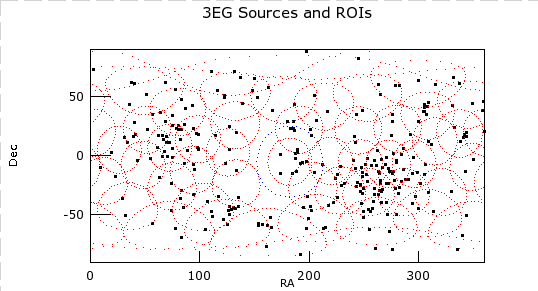
Here is a partial table of the results
DC1 3EG
ID ROI ROI dist. flux index TS flux index catalog ID
0 0 1.82 8.11e-03 1.88 228.95 4.23e-03 1.85 3EG J0010+7309
1 5 11.93 3.42e-03 2.51 35.59 1.20e-03 2.70 3EG J0038-0949
2 4 7.05 1.89e-03 2.61 16.34 5.10e-04 2.63 3EG J0118+0248
3 5 10.44 1.70e-03 3.40 21.07 1.16e-03 2.50 3EG J0130-1758
4 6 7.19 2.78e-03 3.18 37.89 9.80e-04 2.89 3EG J0159-3603
5 4 11.24 1.96e-03 2.67 10.82 8.70e-04 2.23 3EG J0204+1458
6 6 8.50 2.00e-02 2.16 740.77 8.55e-03 1.99 3EG J0210-5055
7 4 10.04 3.06e-03 2.22 49.66 9.30e-04 2.03 3EG J0215+1123
8 1 14.94 7.51e-03 2.33 134.20 1.87e-03 2.01 3EG J0222+4253
9 1 9.83 1.22e-02 2.49 56.50 3.79e-03 2.29 3EG J0229+6151
10 3 12.88 6.09e-03 1.97 124.29 2.59e-03 1.85 3EG J0237+1635
11 3 12.53 4.13e-03 3.25 49.75 1.38e-03 2.53 3EG J0239+2815
12 1 8.23 1.19e-02 1.96 108.65 6.93e-03 2.21 3EG J0241+6103
13 3 10.57 2.52e-03 2.47 17.66 8.80e-04 2.61 3EG J0245+1758
14 9 6.13 2.84e-03 2.62 29.34 6.20e-04 2.10 3EG J0253-0345
15 1 3.26 5.67e-03 2.23 36.74 9.70e-04 2.38 3EG J0323+5122
16 3 0.52 4.91e-03 2.53 42.87 7.40e-04 2.61 3EG J0329+2149
17 9 8.89 4.55e-03 2.17 90.63 1.51e-03 1.84 3EG J0340-0201
18 3 14.14 4.96e-03 2.46 43.65 1.15e-03 2.16 3EG J0348+3510
19 7 7.96 1.03e-03 1.87 18.49 3.80e-04 2.10 3EG J0348-5708
20 8 11.54 3.24e-03 3.10 25.70 1.11e-03 2.65 3EG J0404+0700
The units of flux are  for both the DC1 and 3EG values. Here is a plot of the fitted DC1 flux vs 3EG flux:
for both the DC1 and 3EG values. Here is a plot of the fitted DC1 flux vs 3EG flux:
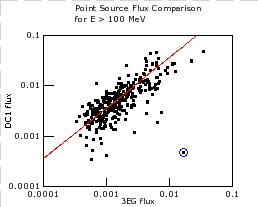
A comparison of the spectral indices for these DC1 fits versus the 3EG values is more reassuring:
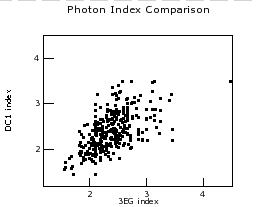
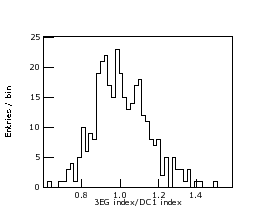
Finally, here is a scatter plot of DC1/3EG index ratio versus flux ratio for which no obvious correlation is seen:
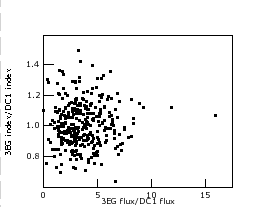
Here are plots of these normalizations as a function of Galactic latitude:
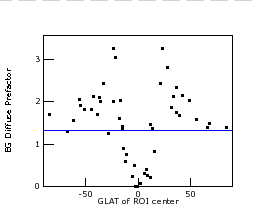
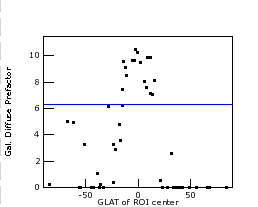
 ), and for the Galactic diffuse emission, the power-law Prefactor should be 6.31. Those values are indicated by the blue horizontal lines in the respective plots.
), and for the Galactic diffuse emission, the power-law Prefactor should be 6.31. Those values are indicated by the blue horizontal lines in the respective plots.At high Galactic latitude, where the Galactic diffuse emission makes only a very small contribution, the extragalactic Prefactor has fitted values that roughly agree with the nominal value of 1.32. In regions where the Galactic diffuse emission is more important, i.e., at lower Galactic latitudes, the relative normalization between the two diffuse components is strongly anti-correlated. This occurs because within a relatively small region of interest (and for a relatively small number of events), there is insufficient structure in the Galactic diffuse emission to distinguish it from an isotropic component. Plotting the two Prefactors against each other, the anti-correlation is clear:
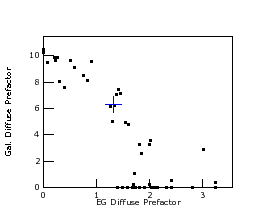
 1.3-rc3
1.3-rc3